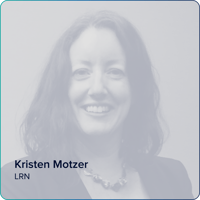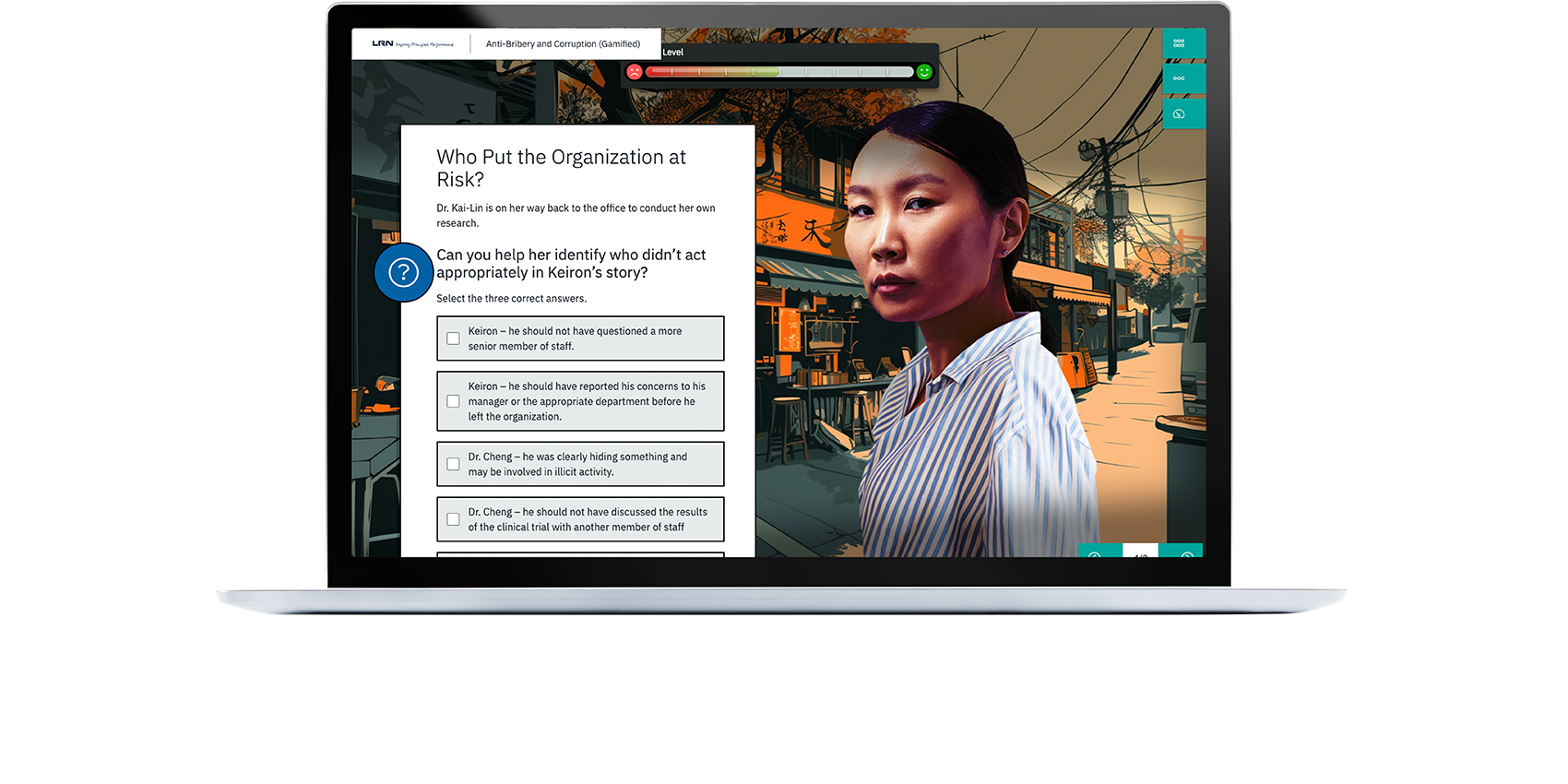What you'll learn on this podcast episode
Most of us have heard the phrase, “If you see something, say something.” But what does that look like when someone witnesses bad behavior in the workplace? How can companies help their employees be active bystanders in the face of misconduct? In this episode, LRN colleagues Felicity Duncan, senior instructional designer, and Kristen Motzer, learning director, share their expertise on bystander intervention training and how organizations can effectively give employees the knowledge and skills they need to step in and help their coworkers. Listen in as the two share insights from their latest course development for the training library at LRN.
Principled Podcast Show Notes
- [1:22] - What does it mean to be a bystander, and why do organizations have bystander training?
- [3:05] - Unpacking the idea of a “Speak up culture”.
- [3:40] - Why don’t people get involved when they see problems?
- [6:08] - How to train people to be active bystanders?
- [9:36] - Why are scenarios so important?
- [12:14] - How DEI relates to bystander intervention.
- [15:26] - How having a robust bystanding and speak up culture will benefit partners.
Where to stream
Be sure to subscribe to the Principled Podcast wherever you get your podcasts.
Guest: Kristen Motzer
Kristen Motzer is an experienced leader in values-driven, empathetic behavior change. As Learning Director for the LRN Library she oversees course content development and online, blended, and facilitated learning experiences. She has expertise in human-centered learning design and has developed and managed education and learning programs at institutions such as NYU Langone Health, NeuroLeadership Insitute, Stanford University, Xavier University, and the Cleveland Clinic. Kristen holds a BA from Wright State University and an MA from Carnegie Mellon University and resides in Chicago.
Host: Felicity Duncan
Dr. Felicity Duncan believes that training and communication interventions have the power to transform behavior, including driving people toward more ethical treatment of those around them.
Felicity graduated with a Ph.D. in Communication from the University of Pennsylvania. After teaching at the college level for several years, she transitioned to workplace education to have a bigger impact on working adults by providing them with the training they need to truly thrive in their roles. At LRN, she is focused on developing high-impact, behaviorally focused content for the LRN Library. Her most recent project saw her working with the Library team to create a powerful new DEI Program that includes not only LRN’s world-class Inspire courses but also a set of microlearning assets designed to support, reinforce, and guide behavior change.
Principled Podcast Transcription
Intro: Welcome to the Principled Podcast, brought to you by LRN. The Principled Podcast brings together the collective wisdom on ethics, business and compliance, transformative stories of leadership, and inspiring workplace culture. Listen in to discover valuable strategies from our community of business leaders and workplace change makers.
Felicity Duncan: Most of us have heard the phrase, "If you see something, say something." But what does that actually look like when someone witnesses bad behavior in their workplace, like bullying or harassment? And how can companies help their employees be active bystanders in the face of misconduct? Hello, and welcome to another episode of LRN's Principled podcast. I'm your host, Felicity Duncan, Senior Instructional Designer here at LRN. And today, I'm joined by my colleague Kristen Motzer, the Learning Director of LRN's Library Course Content. Kristen has over 20 years of experience in technology supported learning and development, and I am a PhD with a decade of experience working in both academic and professional training environments. Kristen, thanks for joining me on today's Principled podcast. So, let's start with the basics. What does it mean to be a bystander and why do organizations have bystander training? Can you explain the sort of core idea here?
Kristen Motzer: Sure. A bystander is someone who witnesses misconduct but isn't directly involved in the situation. So, they see something happening, but they're not actually a part of it. So, being an active bystander is about doing something as opposed to just standing by when you see someone being harassed or bullied or abused. And there's actually a lot of research showing that bystander intervention can have a major impact. When bystanders intervene in situations in the right way, they can stop abuse in its tracks, support victims, and really make perpetrators reevaluate their behavior.
However, very often bystanders witness abuse and harassment and say nothing. That's why we need active bystander training that equips people with the tools they need to intervene successfully when they see something wrong. So, recently we've seen a lot of interest in bystander training from our partners, and Chicago now has an requirement for our long bystander of training for employees in Chicago. But really beyond that, there's a recognition that engaging your workforce to do something, to fight back, to say this is not behavior that we want to have in our workplace can be really powerful. And it's creating a speak up culture.
Felicity Duncan: So, tell me a little bit more about this idea of the speak up culture. What do we mean by that?
Kristen Motzer: So, it's creating an environment where people feel safe to be able to speak up. Of course, speaking up is a little bit scary. You don't know what's going to happen. There could be retaliation, things could change. The folks that usually eat lunch with might not want to eat lunch with you anymore. Things might change an environment that we spend a lot of time in at work. So, creating a safe space where there's an expectation that you see something that you don't want in your workplace culture, you're going to speak up and say something.
Felicity Duncan: So, obviously acts of bystander intervention is really important. We really want this speak up culture that's going to help us build a better workplace environment. So, why don't people get involved when they see problems?
Kristen Motzer: It's a great question, and it's really important to understand that it's not because people don't care. It's not that we're bad people at work or wherever we might be. It's that we're human. And intervening can be really difficult. Psychology has shown research from the 60s and onward that people have good intentions, and people tend to actually believe that if they saw something happening like harassment, discrimination, that they would get involved. But when it actually happens, that intention that they would get involved disappears and they just freeze up. And it's because of our fight, flight, freeze response kicking in. We're facing an unknown situation. We don't know how the people involved will react, and we're just scared of looking stupid, upsetting someone, getting into trouble, being embarrassed besides the possible outcomes like having some kind of retribution losing our job or our workplace friendships. So, from a biological and neuroscience perspective, our brains flood with stress hormones and react as though we're facing something like a bear, a really dangerous situation even though it's a social threat, not an actual bear, it can feel just as intense.
So, when this happens, it's really hard for humans to overcome these instincts and get involved. So, we freeze. We try not to make eye contact, we put our heads down, try to hide, and if we're in a group, behavioral psychology research is found that it's even worse. So, when there's multiple people witnessing a situation, everyone's kind of expecting someone else is going to take action, and we sort of take the lead of kind of like group think. We take the lead from those around us, and if they're not doing anything, then we won't do anything. We have all these reasons why people don't intervene when they're bystanders. And Felicity, given these barriers, how do you train someone to be a bystander at work? I would love for you to take me through how you created the Inspire Active Bystander Training.
Felicity Duncan: Well, luckily for us, the research that you mentioned earlier that talks about why bystanders don't intervene also gives us hope. It shows us how we can overcome those barriers to intervention. At what it really boils down to is being prepared, right? Being ready to get involved in these situations. But the truth is, it's a long road to get learners to that point. So, I'm going to walk you through what we did and why we think that works. So, we begin our training by acknowledging that this is hard. As you said, a lot of people assume that if they're in a bystander situation, that they're going to do the right thing, and then when it actually happens, they're unprepared for how scary it is, and for how strongly and viscerally they react to that fear, right? And so what we try to begin with is getting our learners to understand what to expect, right?
We're really frank about the fact that it's going to be scary. Your palms are going to be sweaty, your heart is going to be pounding. You're going to be really afraid, all right? And telling them that feel the fear, but overcome it because that is not a reason not to intervene. It's just part of the experience. And so, in that way, we try to help prepare them for how it's actually going to be. What they're actually going to feel when a situation arises where they need to make some kind of intervention. Then what we do is we give learners some very practical strategies for how to intervene. And again, we're preparing them, right? We give them a literal list of step one, step two, step three, Here are four possible approaches to intervention. Here's how you would implement those approaches to intervention. So, it gets incredibly practical so that when learners are faced with these situations in the real world, they don't have to think like, "Oh, what am I going to do?" They have a set of actual steps that they can take.
And then finally, we let them essentially practice using literally dozens of real world scenarios. And there's an important point here that I want to make about our training is that it's really focused on the workplace. Now, a lot of the research that you mentioned earlier, and a lot of general bystander research comes from non-workplace environments. So, a lot of it comes from campus sexual assault prevention and also from street harassment. So, we're getting involved in preventing street harassment more recently. And those are really different situations to what you'd face in the workplace, right?. In a street harassment, there's a real threat of violence, its strangers. What's at stake is perhaps your physical safety. And of course in sexual assault, if we're talking particularly, a lot of this work is done on college campuses, there's a lot more social pressure. People are really afraid of offending their friends. And that's really different to what's at stake in the workplace.
You mentioned earlier the issue of retribution and retaliation. So, if I get involved, is that going to undermine my promotion? If I say something, am I going to start getting put onto bad projects? So, we really try to dig into the fears and issues that arise in a workplace context and our scenarios are really focused on that.
Kristen Motzer: So, let's talk about this a little bit more. You mentioned scenarios multiple times, and I know this learning experience that we've created includes dozens of scenarios. So, why are these so important?
Felicity Duncan: It really comes down to that question that you asked originally. What can we do to help learners overcome their biological resistance to saying something and get them to actually take action when they're witnessing misconduct? And as we said, the key is preparation. And we know the best way to prepare for a situation is to really think in very concrete terms about what you would do in that situation. In all kinds of training scenarios, we really focused on planning and preparation to help you deal with the situation that might be emotionally difficult.
And so, our scenarios illustrate dozens of real world scenarios that our learners or people encounter every day. So, a coworker telling a sexist joke maybe, and abusive customer using racist language. And then we look at like, "How do you handle those situations as a bystander who is witnessing misconduct?" So, in other words, we ask people, "What would you do in this situation? What's the right thing to do? What are the possible consequences of doing that?" And that gives us an opportunity to talk about retaliation and sort of the protections that exist in workplaces to keep people safe from retaliation.
So, the idea is to really help learners engage with the practical steps that they should take when they're bystanders. Because the more someone plans their responses to different situations, the more likely that person is to actually take action when they're faced with those situations. And what we want to do by giving all these scenarios, by giving these practical strategies and steps that we're providing in our training, is equip learners with a practical toolkit of responses. So, when they're in that bad situation and their heart is pounding and their palms are sweating, and they're feeling anxious and they're scared, they don't have to think, "What should I do?" They know what to do and they're ready to do it. And that's really the only way to help people overcome these natural biological barriers to intervening in bad situations. But Kristen, I want to ask you, in our library, we've put bystander training in our diversity, equity, and inclusion suite of content. So, why have we conceptualized bystander training as part of DEI?
Kristen Motzer: That's a really great question and an important one. So, if we think about our philosophy at LRN, and within our inspire content with the library, we think about DEI as the antidote to harassment and discrimination. So, diversity, equity and inclusion content around respect, allyship, these are the kinds of things that the mindset and the skills we build that will prevent harassment and discrimination.
So, if we think about bystander and being able to put that respect and allyship to work, when you see something that needs to be dealt with, that should be reported, bystander intervention isn't just about harassment and discrimination and these kinds of scenarios. It's about as much that helps our HD programs. It's about a kind of culture that you want to build. It's not just about preventing the worst kinds of sexual harassment and discrimination. It's about actively speaking up and knowing that when people see microaggressions, when they see subtle behavior that excludes people, that hurts victims. But it's not illegal. It's not quite at that level of being something illegal, but it's saying, this is not something that we want to see in our culture and our culture, we treat people with respect no matter who they are.
And DEI is about building a culture that gives everyone the freedom to be themselves and the tools they need so they can thrive and make their best contribution and be these ethical employees in this ethical culture that we want to have. And we have to decide that's what we want to create, and that's what we want to protect. So, it's more than just preventing the worst kinds of bad behavior. It's about being intentional in saying instead of just thinking prevention, we're going to build. We're positively choosing these behaviors that create an equitable and inclusive culture for everyone. So, we see bystander training as a critical part of this broader DEI program, and it's really seeing it as a tool that can enable our partners and employees to create and maintain the kind of culture that they want to have at work.
Felicity Duncan: I think that's a really important point, and it's essentially the difference between doing the baseline of compliance and moving further beyond that to actively create good. At LRN, we argue that by doing that, by going beyond, we obey the basic rules to we actively try to make a great environment, that is a real business advantage for organizations that that taking those extra steps is not only the right thing to do, but it's also the smart thing to do. So, can you talk a bit about how you would see having a robust bystander training program and having a speak up culture is actually going to benefit partners beyond the sort of avoiding the fines and problems that come with harassment?
Kristen Motzer: Absolutely. That's a great question. So, if we think about this kind of culture where employees speak up, it's a culture where employees feel trust. And we know that employees feel that trust, not only will they speak up, but they will behave more ethically. In general, they will feel, this is the environment we're in, this is what the culture expects from me. This is what the highest levels of leadership expect from employees and from our culture. This is what we do here. So, if you think about that trust and that psychological safety of being able to be who I am and know that I can speak up, if I see behavior that I don't want in the workplace, I go to work to do a good job, to do something that I'm passionate about doing, and I shouldn't have to worry about am I going to get harassed today or discriminated against.
So, it's really in everyone's best interest to create this culture, because also the trust, it increases engagement. So, every organization wants engaged employees. It's good for business. So, if we think about this kind of culture that encourages people to be themselves and to stand up for others, then you've got employees who are engaged with the organization, with its values and the mission that it's trying to achieve, and that's good for everyone.
Felicity Duncan: See, and I think it's really important to draw these connections because you can think about bystander training as being, well, there's this new Chicago requirement and we're going to have to give people an hour of bystander training and get that compliance box ticks. But I think it's really important for companies to think about this more broadly. About culture, about engagement, about having happy people in your office who are there for more productive, right? None of this is happening in isolation as a box ticking exercise. It's really all about building the kind of workplaces where people want to be.
Kristen Motzer: Absolutely.
Felicity Duncan: But clearly this is a conversation we could be having all day, but we are out of time for today. Kristen, thank you so much for joining me on this episode. My name is Felicity Duncan, and I want to thank you all for listening to the Principled Podcast by LRN.
Outro: We hope you enjoyed this episode. The Principled Podcast is brought to you by LRN. At LRN, our mission is to inspire principled performance in global organizations by helping them foster winning ethical cultures rooted in sustainable values. Please visit us at lrn.com to learn more. And if you enjoyed this episode, subscribe to our podcasts on Apple Podcasts, Stitcher, Google Podcasts, or wherever you listen. And don't forget to leave us a review.
Be sure to subscribe to the Principled Podcast wherever you get your podcasts.
















